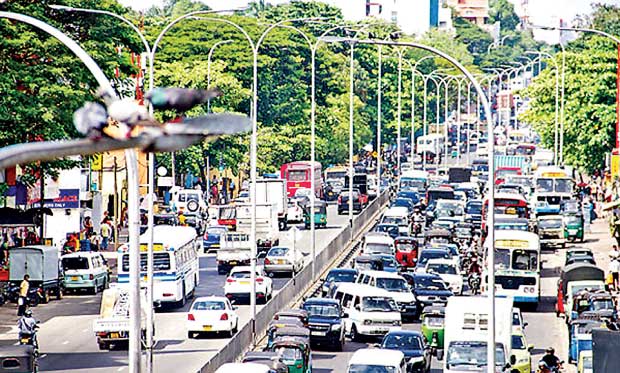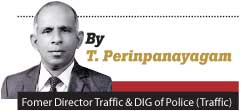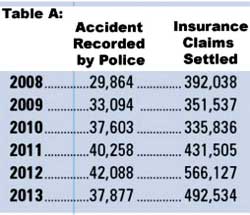Reply To:
Name - Reply Comment
Last Updated : 2024-04-19 06:03:00

 Eight Sri Lankans losing their precious lives in road collisions daily, it is high time that we as concerned professionals addressed numerous facets of ‘Traffic Accidents’ and discuss matters topical, especially the proposed increase in traffic fines.
Eight Sri Lankans losing their precious lives in road collisions daily, it is high time that we as concerned professionals addressed numerous facets of ‘Traffic Accidents’ and discuss matters topical, especially the proposed increase in traffic fines.
In this context, I wish to place the following extracts drawn from the final report presented in Parliament on December 12, 2014 by a Select Committee which looked into the alarming increase in traffic accidents.
The following information, which would refresh your memory in deciding whether the proposed increase in traffic fines should be implemented, will be important. Extracts from the report along with my observations have been included. The Government bears the primary responsibility for road safety. Traffic accidents need to draw serious attention of the Government, in addition to the political will and the commitment of the Government.
Improving road safety should be considered as a social imperative and the Government should be held accountable for its actions and failures.
Road accidents are a huge and complex problem — and active participation of many organisations and sectors is required to overcome this situation.
The conditions of roads are one of the important factors causing traffic accidents. This is recognised by road safety experts all over the world.
World Health Organisation identify the status of roads as a major factor for accidents. Therefore regular maintenance of roads is equally important to achieve road safety.
According to the National Road Master Plan (2007-2017) of the Road Development Authority, at Independence in 1948, Sri Lanka had about 11,000 km of trunk roads (Highways), of which 7,000 km were paved
Accordingly, only a little mileage (‘B’ class roads) — 726 Km — has been added to the road network in Sri Lanka in the past 64 years after Independence: ‘A’ roads-nil, ‘AB’ roads- nil, and ‘AC’ roads- nil, except for the two expressways. Nevertheless, the total vehicle population of the country has increased by about 298 percent in the past 16 years. The vehicle population in 2000 was 1,706,382 and it had increased to 6,795,469 in 2016 — a 298 percent increase.
 The Ministry of Highways in its website has acknowledged the inadequacy of the road network to meet the increasing traffic volume. As per the website, even though Sri Lanka has an extensive road network, most roads were built about 50 years ago and do not possess the capacity to cope with increasing traffic volumes. Therefore there’s an urgent need to improve the capacity and efficiency of the road network to meet the growing transport requirements of the country and avoid the road network becoming an impediment to national development. Any delay in improving the road network to meet the increasing number of vehicles will lead to greater traffic congestion and a higher rate of accidents, especially in the urban areas, and economic loss.
The Ministry of Highways in its website has acknowledged the inadequacy of the road network to meet the increasing traffic volume. As per the website, even though Sri Lanka has an extensive road network, most roads were built about 50 years ago and do not possess the capacity to cope with increasing traffic volumes. Therefore there’s an urgent need to improve the capacity and efficiency of the road network to meet the growing transport requirements of the country and avoid the road network becoming an impediment to national development. Any delay in improving the road network to meet the increasing number of vehicles will lead to greater traffic congestion and a higher rate of accidents, especially in the urban areas, and economic loss.
Traffic levels now exceed the designed capacity of many trunk roads. Increasing traffic volumes and a traffic mix consisting of motorised and non-motorised traffic have resulted in low traffic speeds, severe traffic congestions and increased accident rates. The capacity constraints have created severe safety problems.
According to the Asian Development Bank, the road capacity in Sri Lanka will need to be doubled every 08 to 10 years to meet the rising demand.
It is the responsibility of the Transport Ministry to provide the public with an efficient and safe system of transport — both by road and rail at affordable cost and a service that is responsive to social and economic development needs in the country.
Traffic congestion has become a major challenge on Sri Lankan roads, especially in urban areas. Traffic congestion may be defined as having more vehicles on the road than it was designed for.
The use of private vehicles has increased rapidly over the past 12 years. Three wheelers and motorcycles which are more prone to accidents contribute immensely for this increase:
- Supervision of driving schools
The committee sees an urgent need to maintain a continuous supervision of driving schools by the Motor Traffic Department to ensure proper licensing and driver training under a uniform curriculum.
Action to be taken to appoint raid parties to conduct surprise inspection of driving schools by a team comprising officials of the Transport Ministry, the Department of Motor traffic and Police (excluding the Examiner of Motor Vehicles).
The Ministry of Transport may establish a task force to carry out surprise checks on driver training schools with the participation of officials from the Ministry, the Department of Motor Traffic and Police (excluding the Examiner of Motor Vehicles).
The Present system of issuing licenses by the Department has to be improved with a new computerised system, subject to a mandatory probationary period.
Apparently due to unsatisfactory practical tests conducted by the Department in issuing driving licences, inexperienced drivers get involved in accidents.
- Ministry of Law and Order and Department of Police
The Ministry of Law and Order and its main law enforcement arm – the Police Department. Although the task of the Police is unenvious, they still need to maintain the highest standards of integrity and road discipline while carrying out their duties often under trying conditions.
Effective traffic law enforcement plays an important role in reducing traffic accidents.
- Strict implementation of existing laws
The road users in Sri Lanka, like in other developing countries, have a tendency to break traffic laws, since laws are not strictly implemented.
- Accident statistics to be co-related
A comparison of accidents data compiled by the Police and the Insurance Association of Sri Lanka show a high discrepancy.
Hence the statistics can be rather misleading and not conducive to research and planning activities.
Act No. 08 of 2009 requires drivers to report accidents at Police Stations. Apparently, there is reluctance on the part of drivers to report accidents at police stations perhaps due to inconvenience involved, time taken to record statements, and to get the vehicles released from stations.
Aimed at reducing road accidents, the Department of Motor Traffic under MTA section 123, 133A and 139 E came up with a driver improvement point system in driving licences. The system has not yet been implemented due to a few practical problems.
The present Highway Code was gazetted in 1987. The Department of Motor Traffic should take early steps to update the Highway Code.
Several requests to update the Code have been made to the Commissioners General of Motor Traffic in the past 30 years but little or nothing has happened.
The Ministry of Transport or the Department of Motor Traffic has so far not issued endorsement forms to motorists and to new drivers who pass the driving test.
The endorsement form should be part and parcel of one’s driving licence and should be produced to a police officer on request. It refers to section 135/1A of the Motor Traffic (Amendment) Act No 8 of 2009. Any person who fails to carry a valid learners’ permit or regular driving license including the endorsement form while driving a motor vehicle shall be guilty of an offence and shall on conviction be liable to a fine not less that Rs 2,500 and not exceeding Rs 5,000.
The Committee recommends that a National Policy on Road Safety be formulated based on matters highlighted in its report.
It is clear that the proposed increase in traffic fines for motorists cannot be justified with the restrictions and constraints placed against them since 1984 and with the inadequacy of the road capacity to cope with the increase in traffic volume by 298 percent. The motorists have been prevented from following or obeying the road rules enacted under Section 148 of the Motor Traffic Act.
The relevant Authorities are responsible for the present situation in the country in failing to provide reasonable road capacity on the roads for the smooth flow of traffic.
Therefore, the Government should withhold the proposed increase in fines until the following recommendations are fulfilled without delay by the relevant authorities.
1)The road capacity needs immediate improvement to meet the growing transport requirement.
2)Transportation of all light vehicles is to be restricted temporarily.
3) Speed-limit boards now installed in an ad hoc manner are to be re installed at the demarcated kilometre spot within the built-up area and non-built-up area.
4)Provide the public with efficient and safe transport system both by road and rail.
5)Driver improvement Point system Regulation published in the Govt. Gazette No. 1726/12 dated 5/10/2011 should be amended and implemented.
6)The Endorsement Form system (M. T. A 32 c Section 125 of the M. T. Act published in the Govt. Gazette No. 605/6 of 11/4/1990) is to be implemented without delay.
7)No Parking and Parking and Standing boards erected on all roads- A, B, AB, C and provincial roads are all invalid and illegal. Authorities have failed to erect approved sign boards with panels affixed to the boards as per Govt. Gazette No. 444/18 of 13/3/1987 prior to police prosecution.
8)For the information of the public, Radar Speed Meter Guns to be gazetted as per Govt. Gazette No. 827/13 dated 14/6/1994 along with the procedures in detecting speeding vehicles.
9)National Thoroughfare Act No. 40 of 2008: There are serious errors and omissions in the Act and in the Expressway Regulations No. 2/2011 published in the Govt. Gazette No. 1717/4 of 03/08/2011. The entire Act and the Regulation should be repealed and a fresh Act and a Regulation should be enacted.
10)Traffic officers are to be trained (Refresher courses) prior to being detailed for traffic duties. Strict enforcement of the law is to be observed.
The relevant authorities could take remedial measures in the coming months to reach a reasonable target before the United Nations Resolutions for Decade of Action for Road Safety 2011-2020 concludes.
A reasonable increase in fines for the 14 different category of vehicles may be considered, given the constraints placed on the motorists except for offences as stated on page 2 of the report.
My conclusion is that;
1. The need to increase fines for motorists would not have arisen, if the Ministry of Transport and the Department of Motor Traffic had continued with the implementation of the two Regulations — (a) Driver Improvement Points (DEMERIT POINTS) system and (b) the Endorsement Form M.T.A. 32 C. The Ministry of Transport and the Department of Motor Traffic should be held responsible for the increase in traffic accidents.
2.The Ministry of Highways and the Road Development Authority failed to increase the road capacity of Roads in relation to the 298 percent increase in the vehicle population.
The Government too has failed to restrict the importation of vehicles to Sri Lanka in relation to the capacity of the road network in Sri Lanka.
3.The Government and all relevant stakeholders should extend their fullest cooperation in achieving the desired results by taking remedial measures in the coming months to reach a reasonable target in view of the Decade of Action for Road Safety 2011-2020 and in compliance with the U N Resolutions on Road Safety.
4.However, prior to the implementation of the increase in the proposed traffic fines, the Government and stakeholders should first improve the ground situation such as the road capacity for the motorists to travel smoothly.
5. It is regrettable to note that since the Final Report was approved by Parliament on December 12, 2014, none of the stakeholders, including the Ministries, the Road Development Authority and the Department of Motor Traffic, have taken positive action to help the motorists and ensure a free flow of traffic.
6.There are 14 categories of vehicles as at 2015 with different sizes, weights, and dimensions. They are: Motorcycles, cars, motor tricycles, buses, dual purpose (vans/cabs), motor lorries, prime movers, lorry and others, ambulances, hearses, land vehicles, NA tractors, LV tractors and lorry trailers.
7.One should take cognizance of the fact that vehicles have different sizes, weights and dimensions that result in the ‘occupancy’ of differing areas of ‘road space’. They pay different fees/charges for emission testing certificates.
8.My personal view is that due to the disparity of vehicle sizes, capacity, dimensions etc the increase in fines should not be the same for all sizes of the 14 categories of vehicles.
9.The previous increase in fines was gazetted by Act No. 12 of 2005. More than eleven years have lapsed. A reasonable increase in fines by 20 percent for the 14 category of vehicles may be considered given the restrictions and constraints placed on motorists on roads, preventing them from following or complying with the road rules gazetted under Section 148 of the Motor Traffic Act and other relevant Traffic laws/Regulations.
10.The enforcement of law in such an errant manner by the Ministry of Transport is a negation of the fundamental rights to equal protection of the law guaranteed by Article 12 (1) of the Constitution.
Copies of the above reports were delivered to the following officials on March 6, 2017:
Secretary/H.E. the President, Secretary/ Ministry of Highways, Secretary/Ministry of Transport, Secretary, Ministry of Law & Order, Secretary, Ministry of Finance, Deputy Solicitor General Yoshitha Rajakaruna, Commissioner General/Dept. of Motor Traffic, Chairman, Road Development Authority, Legal Draftsman, and Inspector General of Police.
It was also sent to the 12 Select Committee members, who approved the above report in Parliament on December 12, 2014 and to the Country Representatives of the World Health Organisation, the Asian Development Bank, the World Bank and the chairman of the Chamber of Commerce.
It is advisable to take appropriate action having digested the detailed report, before this matter is canvassed in a court of Law and in Parliament.
(The writer served as the Director Traffic & Deputy Inspector General of Police (Traffic) for more than 14 years. He also served in National Safety Councils and several National Road Safety Committees. He has engaged in Traffic Administration and Road Safety for well over 30 years in Sri Lanka. He was involved in assisting in drafting laws and regulations relating to the Motor Traffic Act and the Vehicle Ordinance since 1987.)

Add comment
Comments will be edited (grammar, spelling and slang) and authorized at the discretion of Daily Mirror online. The website also has the right not to publish selected comments.
Reply To:
Name - Reply Comment
On March 26, a couple arriving from Thailand was arrested with 88 live animal
According to villagers from Naula-Moragolla out of 105 families 80 can afford
Is the situation in Sri Lanka so grim that locals harbour hope that they coul
A recent post on social media revealed that three purple-faced langurs near t

10 Apr 2024
09 Apr 2024